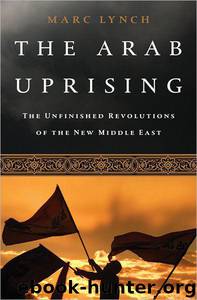The Arab Uprising: The Unfinished Revolutions of the New Middle East by Marc Lynch

Author:Marc Lynch
Language: eng
Format: mobi, epub
Tags: Politics, bought-and-paid-for, on-the-nook
ISBN: 1610390849
Publisher: PublicAffairs
Published: 2012-03-20T04:00:00+00:00
DIRECT INTERVENTION: BAHRAIN
Bahrain was the first great battlefield of the counterrevolution. Launched on February 14, the tenth anniversary of Bahraini King Hamad’s declaration of reformist National Action Charter, for the most part the protest movement demanded reform rather than revolution. In doing so, it built on more than a decade of campaigns for human rights and democratic change, and drew on robust activist networks that had evolved through the years. Bahrain had long had one of the most active online communities in the Arab world, and the most active and visible democracy and human rights movements in the Gulf. Its intermittent protests and vibrant civil society had created a generation of experienced, savvy activists.
The Bahraini monarchy might have been willing to entertain political concessions, given its past reform initiatives. But by the fall of 2010, the regime had become increasingly intolerant, arresting bloggers and journalists and various activists on trumped-up and widely disbelieved charges of conspiring with Iran. Nevertheless, the al-Wefaq society entered October elections to the relatively powerless parliament and won eighteen of forty seats. Despite the advance warning on Facebook, the king declined to attempt any preemptive reforms, and the security forces seemed caught off guard by the size and energy of the actual demonstrations.
The #feb14 movement included a wide range of political groupings as well as many of the newly energized activist youth so familiar from the rest of the region. Their initial protests began joyfully, but were then met with shockingly harsh force. The regime’s initial responses against protests began the violence-mobilization spiral so typical of most Arab cases. Bahraini forces cleared the Pearl Roundabout on February 14, but this only enraged the activists and galvanized much of the population. The troops withdrew after the first day, but then found that Bahraini citizens, shocked by the seemingly indiscriminate use of force, began to join the protests. This repeated a key moment in Egypt, when the activist core was joined by ordinary citizens to transform a typical protest episode into a potentially revolutionary moment. By March, according to some estimates, more than half the population had come into the streets.
The Bahraini regime wavered between confrontation and accommodation. At one point, the monarchy tried to buy off protests with financial subsidies and gifts. As the protests escalated, moderate groups within the regime headed by the crown prince pushed to strike a deal with the opposition on serious political reforms—a path firmly resisted by the conservative, long-serving prime minister and his backers in Riyadh. The crown prince met secretly with al-Wefaq and a half-dozen other legal opposition groups, and seemed ready to organize some sort of national dialogue and move Bahrain past the crisis. The sketches of a pact allowing transition toward constitutional monarchy, which political scientists had long identified as the best way to move from authoritarian rule to democracy, began to emerge. Both sides had credibility problems: the crown prince bargained beneath the shadow of decades of broken promises, while al-Wefaq and its partners could not guarantee that the wider protest movement would be satisfied by what they negotiated.
Download
The Arab Uprising: The Unfinished Revolutions of the New Middle East by Marc Lynch.epub
This site does not store any files on its server. We only index and link to content provided by other sites. Please contact the content providers to delete copyright contents if any and email us, we'll remove relevant links or contents immediately.
The Secret History by Donna Tartt(18767)
The Social Justice Warrior Handbook by Lisa De Pasquale(12087)
Thirteen Reasons Why by Jay Asher(8745)
This Is How You Lose Her by Junot Diaz(6710)
Weapons of Math Destruction by Cathy O'Neil(6090)
Zero to One by Peter Thiel(5643)
Beartown by Fredrik Backman(5556)
The Myth of the Strong Leader by Archie Brown(5380)
The Fire Next Time by James Baldwin(5206)
How Democracies Die by Steven Levitsky & Daniel Ziblatt(5101)
Promise Me, Dad by Joe Biden(5041)
Stone's Rules by Roger Stone(4995)
100 Deadly Skills by Clint Emerson(4806)
A Higher Loyalty: Truth, Lies, and Leadership by James Comey(4803)
Rise and Kill First by Ronen Bergman(4663)
Secrecy World by Jake Bernstein(4599)
The David Icke Guide to the Global Conspiracy (and how to end it) by David Icke(4563)
The Farm by Tom Rob Smith(4409)
The Doomsday Machine by Daniel Ellsberg(4380)
